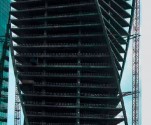Special Measures and Ambient Cure of High-Rise Structures Made from B60 – B100 Series of High-Strength Concrete in the Winter Period

he climatic conditions in most regions of Russia during 4 - 7 months of the year could be characterized as winter conditions, when the average outdoor temperature is below +5°C and the minimum daily temperature is below 0°C. These conditions force to fulfill a specific procedures during the concrete works, which are reflected in the Regulation Code SP70.13330.2012 (updated version of SNIP 3.03.01-87) «Buildings’ supporting structures and envelopes». The monolithic construction from highstrength concrete has high exothermic properties and associated with them temperatures gradient in structure’s body. These temperatures difference greatly affects the thermal stress resistance, cracking resistance and strength of concrete. These features, related to high-strength concrete properties, are forcing to consider additional requirements while using the classes’ В60 – В100 concrete for monolithic structures. The specific of concrete works in winter requires the applying of special measures that assure the achievement by concrete its specified characteristics at low temperatures.
Here are the main conditions that determine the methods of winter concrete works:
a) prevention of concrete mixes freezing while its supplying and pouring in the formworks;
b) maintenance of specified time rates of concrete work, i.e. providing the necessary time for reaching by concrete its specified strength;
c) prevention of thermal cracking resistance in concrete structure due to concrete’s exothermal property and related to it irregular heating and cooling of the structure.
The problems of concrete works in the winter time are solved by using a series of methods:
- concrete mixes should be prepared under above zero temperatures (+5 - +15°C);
- it should be provide the thermal insulation of formworks and heating of adjacent already concreted structures and reinforcing bars;
- it should be maintained the optimum temperature of concrete curing by avoiding the exothermic reaction heat losses and by concrete warming with heating wires;
- the cooling process of concrete structure should be optimized.
Let’s see the particularities of concrete works from high-strength concrete of B60 - B100 classes in the winter time taking into account the experience of construction of six high-rise buildings in MIBC of “Moscow-City”: “Federation”, “Capital City”, “Aqua City Palace”, “Mercury City Tower”, “Wedding Palace” and “Oko.” The total amount of highstrength concrete that was used in rising these buildings is upper than 500,000m³.
Full content of this issue you can read here
The full version of the article can be read in our printed issue, also you can subscribe to the web-version of the magazine.
 Text: ANDREI SHEINFELD, PhD in Technical Sciences, ALEXANDER TARYCHEV, Engineer, SEMEN KAPRIELOV, D.Sc. in Engineering; NIIZhB (The Research, Design and Technological Institute for Concrete and Reinforced Concrete, Moscow)
Text: ANDREI SHEINFELD, PhD in Technical Sciences, ALEXANDER TARYCHEV, Engineer, SEMEN KAPRIELOV, D.Sc. in Engineering; NIIZhB (The Research, Design and Technological Institute for Concrete and Reinforced Concrete, Moscow)


